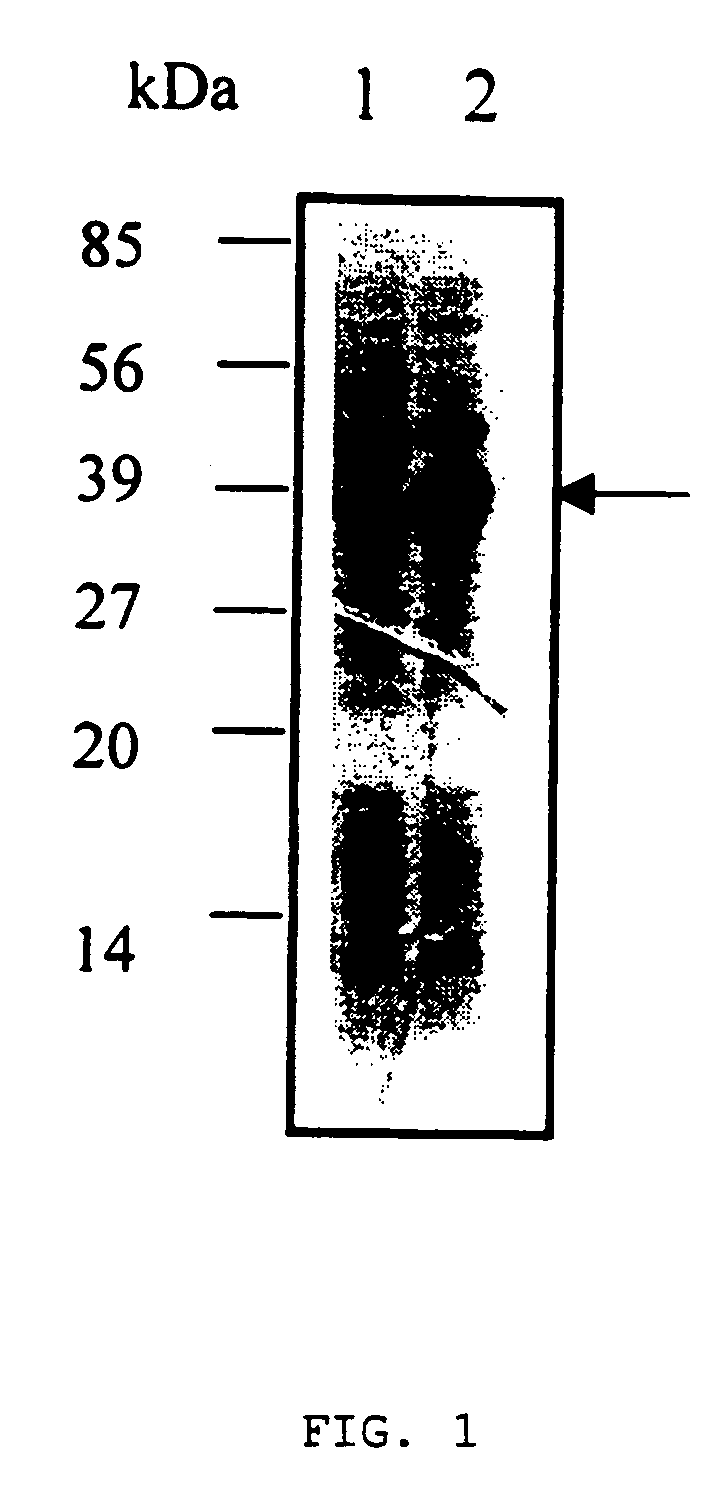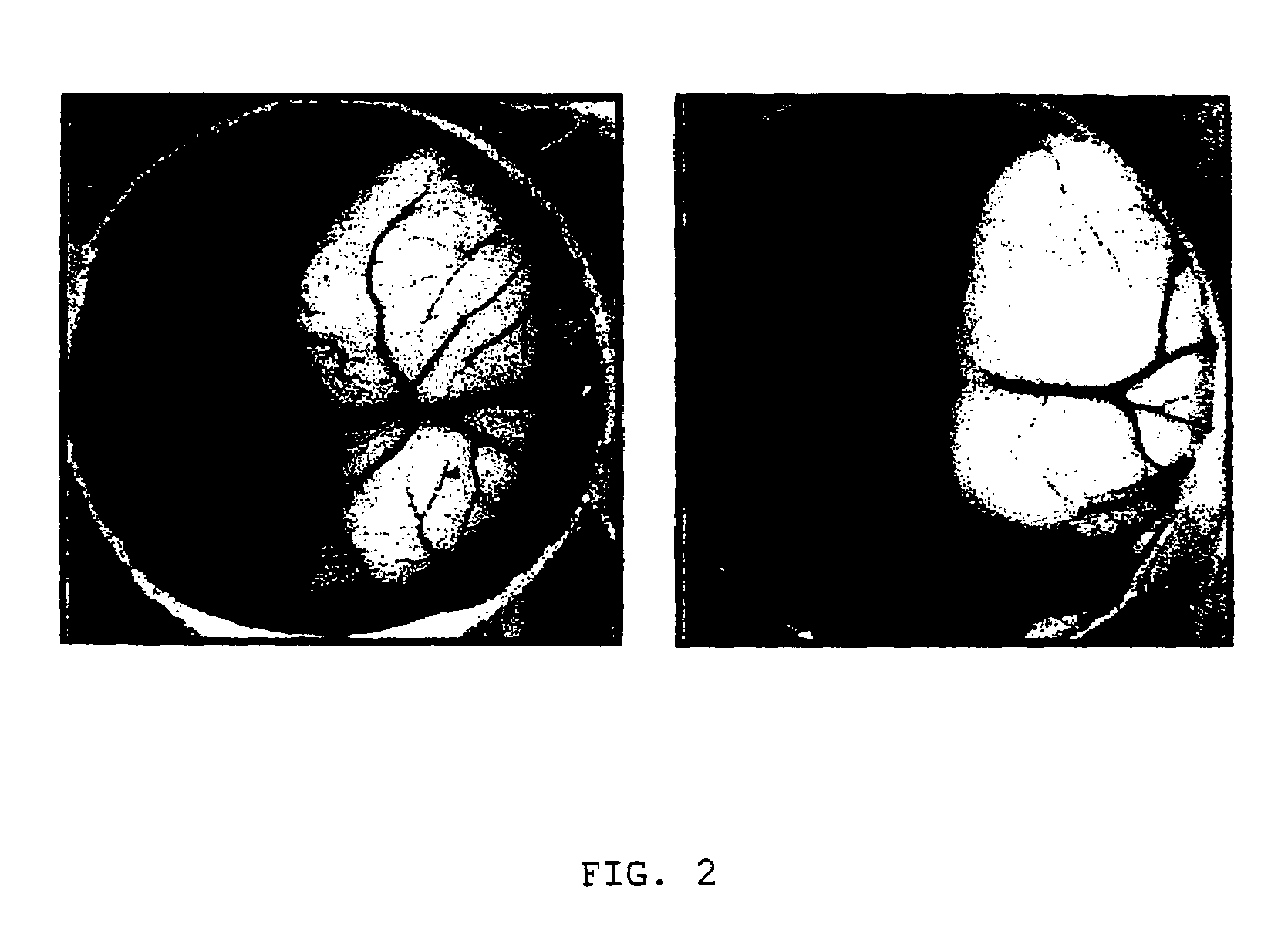Nucleic acid encoding angiogenesis inhibitor
a technology of angiogenesis inhibitors and nucleic acids, applied in the field of new angiogenesis inhibitors, can solve problems such as delay or regression of experimental tumors
- Summary
- Abstract
- Description
- Claims
- Application Information
AI Technical Summary
Benefits of technology
Problems solved by technology
Method used
Image
Examples
example 1
Cloning and Expression of Recombinant LK68
[0044]In order to verify the anti-angiogenic activity of human apo(a) kringle, the inventors cloned and expressed the last three kringles containing IV36, IV37 and V38 as a recombinant protein LK68. A DNA fragment of apo(a) spanning nucleotides 12,052 to 12,975(see: McLean J. W. et al., Nature, 330:132, 1987) was PCR-amplified from human liver cDNA and the resulting 924-bp NdeI-BamHI fragment was ligated into E.coli expression vector pET11a(Novagen, USA). The oligonucleotide primers A(SEQ ID NO: 9)and F(SEQ ID NO: 14) (see: Table 1) were used for PCR amplification under the standard PCR protocol. This clone was named “pET11a / LK68”, which encodes 308 amino acids including human apo(a) kringle domains, IV36, IV37 and V38(see: SEQ NO ID: 2). The first two kringle domains of this clone, IV36 and IV37, are homologous to human plasminogen kringle IV, and the third kringle domain V38 is homologous to human plasminogen kringle V.
[0045]The nucleotide...
example 2
Purification of the Recombinant LK68
[0050]In order to produce the recombinant LK68, high cell-density fermentation was performed in a 5 L Bioflow III bioreactor(New Brunswick Scientifics, Edison, USA) in the following medium: 4%(w / v) yeast extract, 4%(w / v) glycerol, 1%(w / v) dibasic sodium phosphate, 0.2%(w / v) monobasic potassium phosphate and 50 μg / ml ampicillin. When the cells reached an absorbance of 100 at 600 nm, protein expression was induced with 1 mM IPTG and then DO-stat fed-batch was carried out for 9 h with feed media(29%(w / v) yeast extract, 39%(w / v) glycerol and 0.5%(w / v) magnesium sulfate. Cells were harvested by centrifugation at 8000×g for 30 min. Each fermentation process yielded about 80 g of cell / L(wet weight).
[0051]To assess if LK68 was expressed in the soluble fraction or the insoluble cellular fraction of E.coli cells, the inventors analyzed the LK68 expression in these fractions. This analysis showed that LK68 was located in the insoluble cellular fraction. Thus...
example 3
Chick Chorioallantoic Membrane Assay
[0052]In order to determine whether LK68 is anti-angiogenic in vivo, the inventors tested its ability to inhibit the development of capillaries in the chorioallantoic membrane(“CAM”) (see: Lee, T. H. et al., J. Biol. Chem., 273:28805–28812, 1998). Fertilized three-day-old eggs were incubated at 37° C., and a window was made after the extraction of ovalbumin. After two days of incubation, a Thermanox coverslip(Nunc Inc., USA) containing recombinant LK68 protein was applied to the CAM of individual embryos. After 48 h, 20% fat emulsion was injected into the chorioallantois of the embryos, and the vessel formation around the Thermanox was examined(see: FIG. 2). In FIG. 2, the left photograph shows the normal development of capillaries in the CAM; and, the right shows the inhibition of angiogenesis by LK68 on CAM, respectively.
[0053]When LK68 at the dose range of 3–5 μg was applied on the CAM, more than 60% among the 100 eggs tested showed avascular z...
PUM
 Login to View More
Login to View More Abstract
Description
Claims
Application Information
 Login to View More
Login to View More - R&D
- Intellectual Property
- Life Sciences
- Materials
- Tech Scout
- Unparalleled Data Quality
- Higher Quality Content
- 60% Fewer Hallucinations
Browse by: Latest US Patents, China's latest patents, Technical Efficacy Thesaurus, Application Domain, Technology Topic, Popular Technical Reports.
© 2025 PatSnap. All rights reserved.Legal|Privacy policy|Modern Slavery Act Transparency Statement|Sitemap|About US| Contact US: help@patsnap.com



